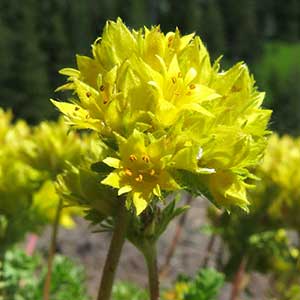Ivesia setosa
Ivesia gordonii
bristly ivesia
alpine ivesia, alpine mousetail, Gordon's ivesia
± ascending to nearly erect, 0.7–2.5(–2.8) dm.
prostrate to erect, (0.2–)0.5–4 dm.
weakly planar to loosely cylindric, 5–9(–12) cm; sheathing base ± strigose abaxially;
petiole 1–8 cm;
lateral leaflets 5–10 per side, separate to overlapping distally, ± flabellate, 2–8 mm, incised ± 3/4 to base, sometimes nearly to base, into (3–)7–11 ovate teeth to narrowly obovate lobes, apex usually ± setose, surfaces ± sparsely hirsute, conspicuously glandular;
terminal leaflets ± indistinct.
tightly to loosely cylindric, (1–)3–20(–25) cm; sheathing base ± glandular abaxially, otherwise glabrous;
petiole 0.5–8 cm, hairs 0.2–0.5 mm;
leaflets (6–)10–25 per side, (1–)2–13(–18) mm, glabrous or ± hirsute or villous, glandular-puberulent or -pubescent, lobes (2–)4–8(–15), linear or narrowly oblanceolate to obovate, apex rarely setose.
(0–)1;
blade vestigial.
1(–2), not paired.
(1–)5–15(–30)-flowered, ± open, 1–6(–12) cm diam.
5–50(–70)-flowered, 1–8(–11) cm diam.;
glomerules 1–several.
5–15(–20) mm.
1–3(–5) mm.
7–10 mm diam.;
epicalyx bractlets 5, lanceolate, 1.3–2.5(–3) mm;
hypanthium patelliform, (1–)1.5–2 × 2–3.5(–4) mm;
sepals (1.5–)2–3.5 mm, ± acute;
petals yellow, oblanceolate to narrowly spatulate, 1.5–2.5 mm;
stamens 5, filaments 0.8–1.5 mm, anthers yellow, oblong, 0.4–0.7 mm;
carpels 2–8, styles 1.2–2 mm.
5–12 mm diam.;
epicalyx bractlets linear to narrowly elliptic, (0.5–)1–3.5(–4) mm;
hypanthium turbinate to campanulate, (1.5–)2–4(–4.5) × 2–4(–5) mm;
sepals (2–)2.5–5(–6) mm, obtuse to ± acute;
petals yellow, narrowly oblanceolate to narrowly spatulate, (1–)1.5–3 mm;
stamens 5, filaments 1.3–2.5 mm, anthers yellow, sometimes red-margined, 0.5–1 mm;
carpels (1–)2–4(–6), styles 2.5–4.5(–6) mm.
greenish white to light tan, 1.7–2 mm, smooth, ± carunculate.
grayish brown to mottled brown, ± 2 mm.
Ivesia setosa
Ivesia gordonii
Ivesia setosa occurs mostly to the east and south of I. baileyi, from southeastern Humboldt and Churchill counties to Elko, White Pine, and northern Nye counties, Nevada, and in the Deep Creek Range of western Utah. It represents a transition between the planar-leaved, chasmophytic members of sect. Setosae and the cylindric-leaved, matted species of flatter sites. Stems of I. setosa are more generally erect than in other species in the section, and the usually calcareous substrate is noteworthy. The deeply incised (usually not quite to base) leaflets are somewhat intermediate between the toothed leaflets of I. baileyi and the leaflets of I. shockleyi that are incised to the base into separate lobes. The individual leaflets of both I. baileyi and I. setosa are more or less flat and distichously paired; in I. shockleyi, groups of leaflet lobes are folded over onto each other, giving a verticillate appearance to the leaflet arrangement.
(Discussion copyrighted by Flora of North America; reprinted with permission.)
Varieties 4 (4 in the flora).
Ivesia gordonii is the most widespread species of the genus, occurring from Washington to Montana, south to central California and Colorado. The species can be distinguished from other members of sect. Ivesia by the relatively deep hypanthium, which is about as deep as wide. Four varieties are provisionally recognized here (B. Ertter and J. L. Reveal 2007), with the likelihood that future work may indicate additional and/or alternate circumscriptions. Populations that are difficult to assign to a variety can be found where the recognizable taxonomic units come together, for example, in northeastern Utah and western Wyoming, involving var. gordonii and var. wasatchensis, and in California and central Idaho where var. alpicola and var. ursinorum tend to merge.
(Discussion copyrighted by Flora of North America; reprinted with permission.)
1. Leaflets 7–13(–18) mm, glabrous or sparsely hirsute or villous marginally; stems (1–)1.5–4 dm; inflorescences usually branched, 2–8(–11) cm diam., glomerules (1–)2–6(–10), ± capitate. | var. wasatchensis |
1. Leaflets (1–)2–7(–9) mm, hairy or ± glabrous except marginally ciliate; stems (0.2–)0.5–2.5 dm; inflorescences simple or branched, 1–3(–5) cm diam., glomerules 1(–3), ± capitate to loosely congested | → 2 |
2. Stems usually prostrate to ascending, rarely nearly erect, usually dark reddish, minutely glandular or glandular-puberulent to -pubescent; leaves to 0.8 cm diam.; anthers usually red-margined. | var. ursinorum |
2. Stems usually ascending to erect, sometimes decumbent, usually greenish, rarely reddish, hirsute to villous, glandular-puberulent to -pubescent; leaves to 1.5 cm diam.; anthers rarely red-margined | → 3 |
3. Stems usually hirsute to villous, sometimes densely so, glandular-pubescent or eglandular; basal leaves (3–)5–10(–15) cm; flowers 7–12 mm diam.; e Idaho and w Montana to Utah, Wyoming, and w Colorado. | var. gordonii |
3. Stems not or sparsely hirsute to villous, glandular-puberulent or -pubescent; basal leaves 2–8(–10) cm; flowers 5–9 mm diam.; s Washington to California and e to w Montana. | var. alpicola |
